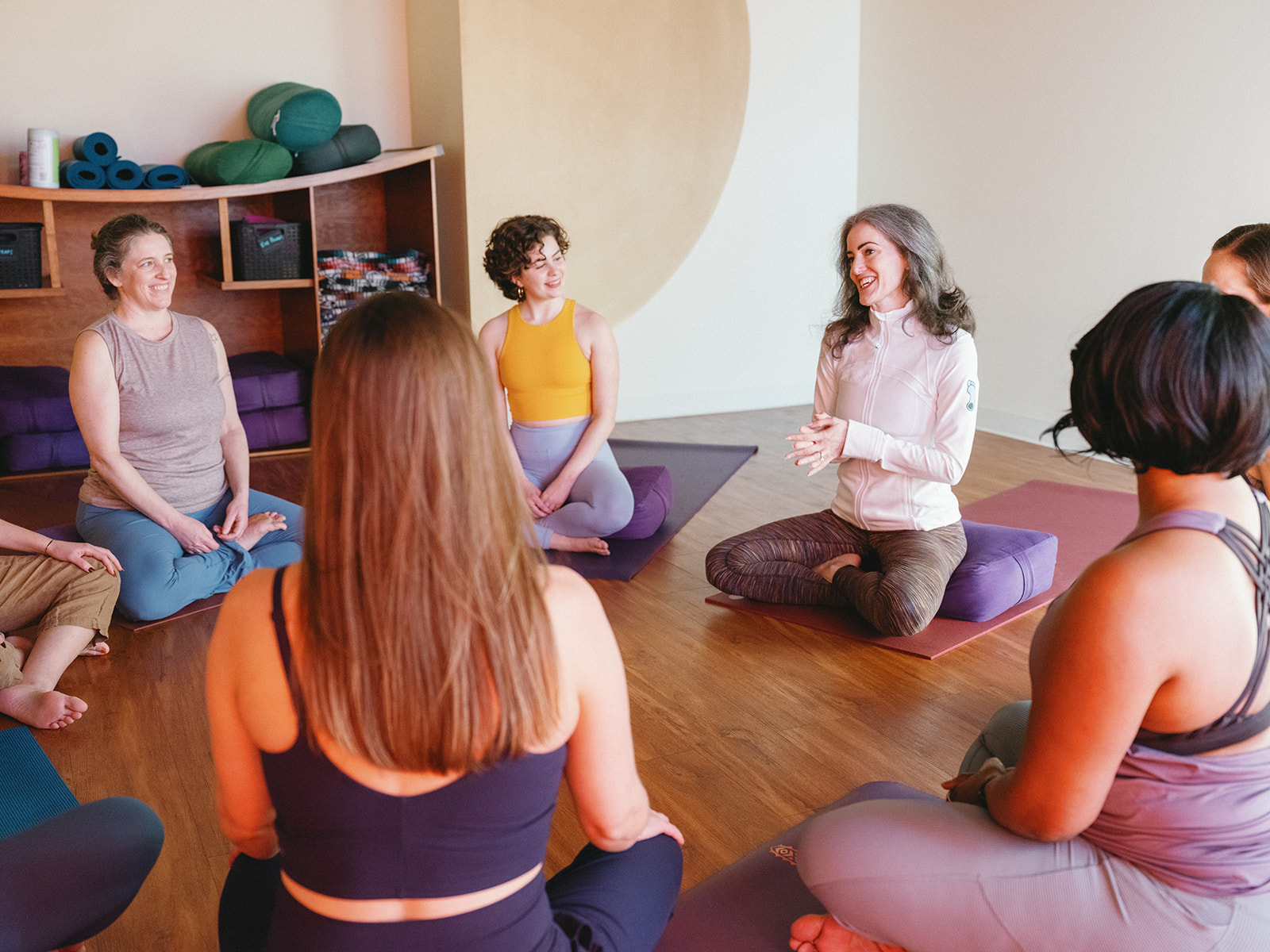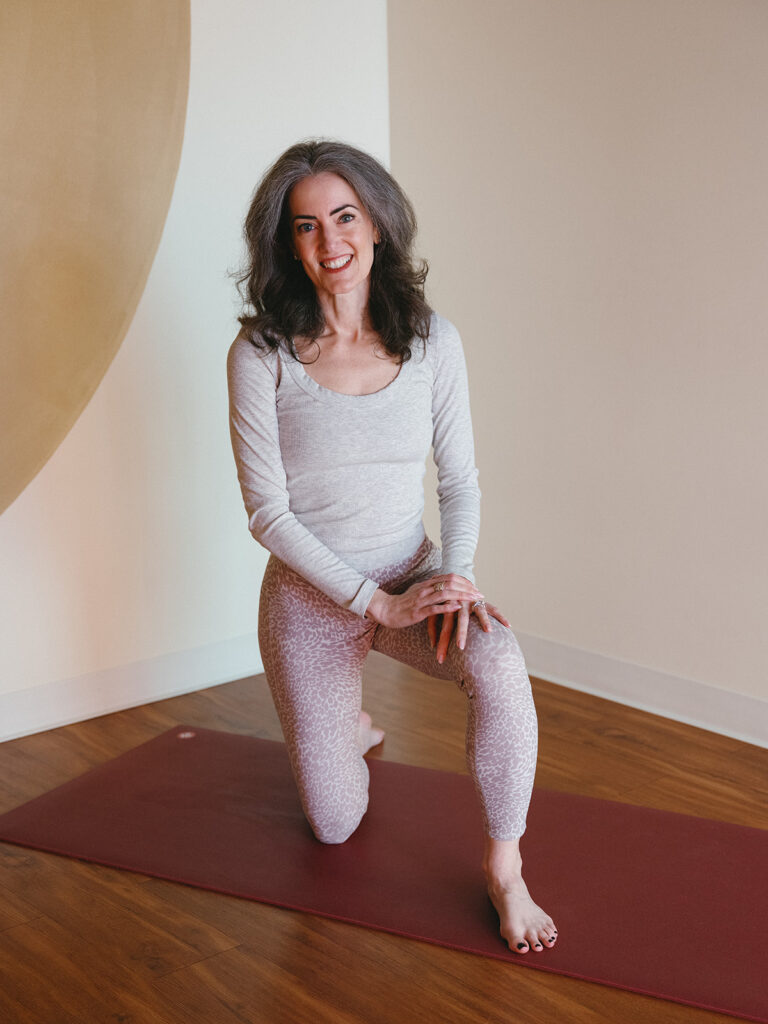I used to think that teaching yin yoga and restorative yoga were specialty skills—nice to have if you wanted to teach those specific classes, but not essential to your development as a yoga teacher. After more than 20 years of teaching and training teachers, I’ve discovered I was completely wrong. Learning to teach yin and restorative might be the most transformative thing you can do for your teaching—no matter what style you teach. In this post, I’m breaking down eight invisible skills you develop from yin and restorative training that will transform how you teach every class format, from vinyasa to hatha to power yoga and beyond.
Understanding Bodies at the Tissue Level
Most 200-hour yoga teacher trainings don’t spend much time on how to recognize what is changeable in a body and what isn’t, and how to discern between compression at the skeletal level and tension at the myofascial level.
When you learn to teach yin yoga, you learn about tension and compression. You learn why holding a pose for thirty seconds creates a totally different effect than holding it for three minutes. You learn about tensile loading and plastic deformation and why the hip anatomy that works for one student creates completely different sensations for another student in the same pose.
Once you understand this—once you really get how the deeper layers of the body work—you start teaching all your classes differently. You stop assuming that if a student can’t do a pose the way you’re demonstrating it, they’re just tight or need to try harder. You start seeing skeletal variation. You understand why some students will never be able to sit cross-legged comfortably or squat with heels on the ground, no matter how much they practice, and it has nothing to do with effort or dedication. It’s about their bones.
When you learn to teach yin, you become a teacher who works with bodies as they actually are, not bodies as you think they should be. This perspective shift transforms how you approach modifications, variations, and individual differences in every class you teach.
The Power of Comfortable Silence
In a vinyasa class, there’s always something to cue. Inhale, arms up. Exhale, fold. The pacing keeps you—and your students—moving. But in yin or restorative, you might set someone up in a pose and then that’s it. They’re there. They don’t need you to talk them through every breath.
This is where newer teachers panic. They feel like they have to fill the space. So they over-cue, philosophize, tell stories that don’t land, or fiddle with the music. Anything to avoid the quiet.
But when you train specifically in yin and restorative, you learn that silence isn’t empty—it’s full. It’s the container your students need to actually feel what’s happening in their bodies. It’s where the practice happens. In our culture, we’re deeply uncomfortable with silence. We fill every gap with sound—podcasts, music, conversation, notifications. We’ve been conditioned to believe that silence means something’s wrong.
In yin and restorative training, you learn that silence is generous. It’s a gift. It’s you trusting that your students don’t need you to narrate their experience for them. Once you get comfortable with silence in a yin class, you bring that comfort with you everywhere. You stop over-cueing in vinyasa. You let your students breathe without narrating every inhale. You learn the difference between helpful instruction and nervous chatter. You learn to speak when speaking serves your students, and to stay quiet when quiet serves them better.
Mastering the Deluxe Savasana
Students remember how you made them feel far more than they remember what poses you taught. And a beautifully held savasana—one where someone feels completely supported, completely safe, completely able to let go—is what they remember. It’s the number-one tool for increasing your class retention.
When you train in restorative yoga, you learn that the setup is the practice. You learn about bolster placement and blanket layering and eye pillow weight and room temperature and lighting and sound. You learn that the difference between a good savasana and a transcendent one is in the details.
You learn which props to use when and where. You learn that a bolster under the knees changes the entire experience of savasana for someone with low back sensitivity. You learn that the weight of the eye pillow matters—too light and it just sits there, too heavy and it’s oppressive. You learn how to fold a blanket so it supports the natural curve of the neck rather than fighting against it.
When you bring restorative skills to your vinyasa class, suddenly your savasanas aren’t just “lie down and relax.” They’re experiences. You know how to set people up so their low backs feel supported. You know whether to cue knees bent or legs long based on what you’ve been teaching. You know how to transition people into stillness instead of just dropping them there. Your students notice, and they keep coming back.
Developing Precision in Language and Reading the Room
Because poses in yin and restorative are held for so long, every word you say lands with more weight. You can’t hide sloppy cueing behind the momentum of a flow. If you tell someone to “relax their shoulders” and that instruction doesn’t actually help them relax their shoulders, they have four more minutes to lie there wondering what you meant.
So you learn to be precise. You learn the difference between “soften your belly” and “let your belly release toward the floor” and “allow your breath to create shape change in your low belly.” You learn that words create experience, and that vague words create vague experiences. This precision makes you better at teaching everything. Your warrior II cues get clearer. Your transitions get smoother. You stop using ten words when three will do.
In yin and restorative, you also learn to read subtler signs in your students. Is someone’s breath deepening or staying shallow? Are their shoulders creeping toward their ears? Is there tension in their jaw even though their body looks relaxed? You learn to see the nervous system, not just the skeletal system. You learn to recognize when someone’s in their zone of tolerance—that sweet spot where they’re experiencing sensation but not overwhelm—and when someone’s ventured outside that zone.
Practical Application: Getting Started
If you’re thinking “This sounds great, but I don’t teach yin or restorative—how do I actually learn this?” here’s the good news: you don’t have to completely overhaul your teaching schedule. You don’t have to become a yin and restorative specialist. You just need fundamental training that gives you the skills.
The Fundamentals of Teaching Yin Yoga and Fundamentals of Teaching Restorative Yoga courses are designed for teachers who want to either start teaching these styles or deepen the skills that make them better at teaching anything. Both courses are structured so you can consume the content however works best for you—video, audio, or reading. You get complete pose libraries with detailed variations, done-for-you lesson plans you can teach right away, shared lesson plan libraries from other teachers, and 20 Continuing Education Units that count toward your 300-hour training.
These courses teach you the technical skills—how to cue poses, when to use props, how to time a class—but they also teach you the invisible skills. How to hold space. How to be comfortable with silence. How to trust your students’ process. How to read fascia and skeletal variation. How to understand what you’re targeting and why. Whether you’re teaching slow classes or fast ones, whether you’re working with beginners or advanced students, whether you’re in a studio or teaching online, these skills will transform your teaching.
Want to dive deeper into all these skills you develop from yin and restorative training? Listen to the full episode of Yoga Teacher Confidential!


